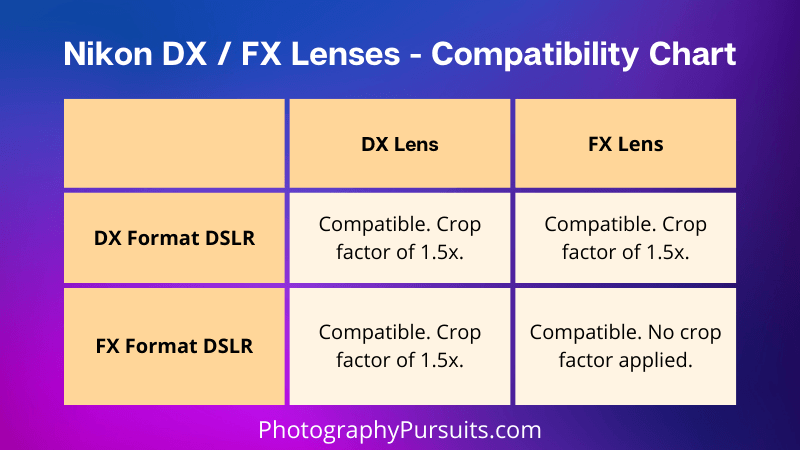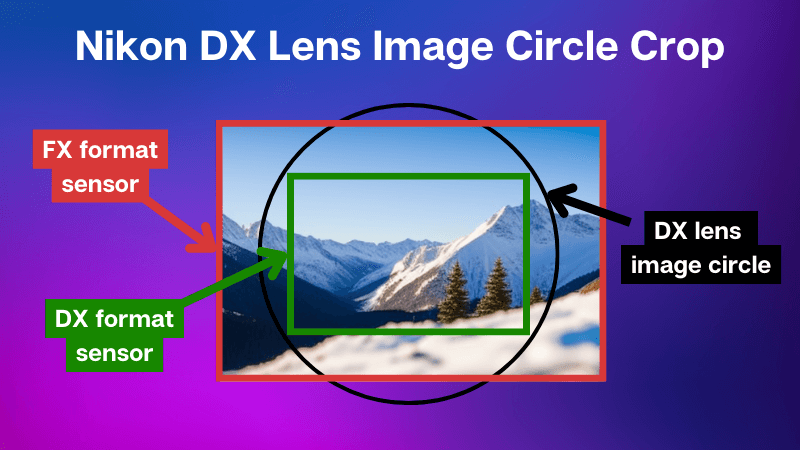Lenses can be confusing, I get it…
Nikon lenses are no exception, and the rules you have to follow are slightly different to Canon lenses.
Here’s a quick summary of what you need to know about Nikon DX lenses and Nikon FX lenses and the differences between them.
Summary:
- FX lenses are Nikon lenses designed for Nikon FX format cameras which are the full frame version of Nikon cameras.
- DX lenses are Nikon lenses designed for Nikon DX format cameras which are the cropped sensor version of Nikon cameras.
- You can use FX lenses on both DX format and FX format cameras, but you will have a crop factor of about 1.5x applied when using an FX lens on a DX format camera.
- You can use DX lenses on both DX format and FX format cameras, but you will have a crop factor of about 1.5x applied when using a DX lens on both DX and FX format cameras.
- FX lenses tend to be higher quality and more expensive whereas DX lenses tend to be slightly lower quality and more affordable.
**Just remember, this post is about using Nikon DSLR lenses with Nikon DSLRs which use the Nikon f-mount.
Nikon mirrorless cameras also come in FX and DX formats, but Nikon mirrorless cameras need an adapter to use Nikon DSLR lenses.
Table of Contents
What Are FX Lenses?
In Nikon’s line of products, the FX abbreviation means that the camera is a full frame camera and FX lenses are made for these full frame FX format cameras.
FX cameras have full frame sized sensors which are approximately 36mm x 24mm in size.
An example of a Nikon FX lens is the Nikon AF-S FX NIKKOR 17-35mm f/2.8D IF-ED
What Are DX Lenses?
DX lenses in Nikon’s range are lenses that are made for Nikon DX cameras which are all crop sensor cameras.
DX cameras have sensors which are approximately 24mm by 16mm in size so they are about 44% of the size of a full frame FX sensor.
This reduction in size allows for smaller and more affordable cameras and lenses compared to FX cameras and lenses.
An example of a DX lens is the Nikon AF-P DX NIKKOR 10-20mm f/4.5-5.6G VR.
Which Is Better – DX Or FX?
If you are comparing them strictly on a technical basis then FX cameras are better than DX cameras.
FX cameras have larger sensors with better low light capabilities and less noise. They are also more likely to have weather sealing.
In general, these cameras also tend to have more sturdy and expensive bodies as they cater towards professional photographers.
The lenses also follow the same general rule so FX lenses will also be of higher quality compared to DX lenses.
However, FX lenses and cameras may not be ‘better’ for everyone because they are also more costly than DX lenses and DX format cameras.
What Type Of Lens Will Fit My Nikon DSLR Camera?
To be clear, any Nikon FX or DX lens will work on both Nikon FX format and DX format cameras.
Here’s a quick graphic below summarising the compatibility of Nikon DX and FX lenses with Nikon DX and FX DSLRs:

What Nikon Cameras Will Fit A DX Lens?
You can use a Nikon FX format or DX format camera with a Nikon DX lens. Just remember that there will be a crop factor applied when using a DX lens.
Unlike the Canon system of lenses, you can use the crop sensor lenses on full frame cameras.
So you can actually use DX lenses on FX format cameras.
The Nikon cameras will automatically compensate for the crop sensor lenses – this is the ‘auto DX crop’. This crop factor is about 1.5x on Nikon cameras.
They have this crop because crop sensor lenses (like DX lenses) have a smaller image circle so they can’t get full coverage of a full frame sensor.

What Nikon Cameras Will Fit An FX Lens?
You can use any Nikon FX format or DX format camera with a Nikon FX lens. Just remember there will be a crop factor applied on a DX format camera.
This is because DX format cameras have smaller sensors than FX cameras.
Since FX lenses are made for the larger sized FX sensors the camera has to apply a crop so that everything matches up. The crop is about 1.5x.
Do The Lenses Affect The Crop Factor?
Yes and no. The thing that controls the crop factor is actually the sensor, but lets run through some scenarios as there is one special case for Nikon cameras.
DX sensor + DX or FX lens:
A DX sensor camera will have a crop factor of 1.5 applied, whatever lens you attach to it.
So a 24mm lens on a DX sensor will look more like a 36mm lens on a full frame.
FX sensor with FX lens:
FX cameras have full frame sensors (what FX lenses were designed for) and the FX lens will not have a crop factor applied.
So a 24mm FX lens will have a field of view equal to a 24mm lens when attached to an FX camera.
FX camera with DX lens: (special case)
In the Canon family of cameras, you can’t use a crop sensor lens on a full frame camera without risking damage and a very strong vignette.
However in the Nikon system, you can use a DX lens on a FX camera quite safely.
The camera will just automatically apply a crop to match the lens as the lenses have a smaller image circle.
So the camera will just take a smaller section of the full frame sensor and only portray the image from that subsection of the sensor.
This works as a crop factor matching that of a DX sensor.
So in this case a 24mm DX lens will have a 1.5x crop factor applied and will look like a 36mm lens full frame equivalent.
Related Reading:
Why Should You Use A DX Lens?
An advantage of DX lenses is the option of wide angle coverage that many of the lenses provide at a lower price point. The issue here though is that you can’t always get quite as wide with as much quality because of the crop factor applied on DX lenses.
For example, consider the Nikon AF-P DX NIKKOR 10-20mm f/4.5-5.6G VR which has an equivalent focal length of 15-30mm (after applying 1.5x crop factor).
But if you went for a full frame wide angle lens of a similar equivalent focal length it’s a completely different story!
The two lenses below are both FX lenses that fall into the wide angle range and cost WAY more than the DX lens above.
As you can see wide angle lenses can be expensive!
Of course it’s not just the focal length that matters and these FX lenses have much better maximum aperture capabilities meaning they are ‘faster’ lenses.
Also they can keep the aperture constant at f2.8 across the whole focal length range whereas the DX lens above ranges between f/4.5-5.6
Often FX lenses are also better in terms of image quality so there is a reason you pay much more for these.
But even with the benefits of an FX lens you can see why people would choose a DX lens if they simply just need that wider angle at a lower price point.
At the end of the day if you need a wide angle because of your subject and you don’t have cash to cough up then a DX will do you wonders.
An obvious scenario where they can be useful is in real estate photography when shooting indoors.
Things like the lower maximum aperture can be accounted for by using tripods and lower shutter speeds if you need more light in your scene.
How To Tell If A Nikon Lens Is DX Or FX
If you are using a Nikon branded Nikkor lens then they will clearly be marked with ‘DX’ somewhere on the lens barrel to show you that it is a DX lens which is made mainly for the DX cameras.
On the other hand, if Nikon made Nikkor Lens without DX on it then you can assume that it is a lens made for a FX format camera.
Strictly speaking there’s no such thing as a FX lens because it is just the standard for full frame. This is why they are not labelled as such because it’s just the base model.
How to Know If Tamron Or Sigma Is Made For DX Or FX Format Camera?
Tamron
Di lenses are made for full frame format cameras, so these would be equivalent to FX lenses.
Di-II lenses are made for APS-C crop sensor cameras so they would be equivalent to DX lenses.
Sigma
DG lenses are made for full frame format cameras, so these would be equivalent to FX lenses.
DC lenses are made for APS-C crop sensor cameras so they would be equivalent to DX lenses.
Compatibility of Third party lenses
Third party lenses can be a great choice as manufacturers like Tamron and Sigma are very reputable and often have more affordable lenses compared to the proprietary brands.
Just make sure that if you do get a third party lens that you ensure you are getting the right lens to match your camera as they make lenses for various manufacturers.
You don’t want to get a Tamron lens for a Canon camera when you have a Nikon!
Should I Buy FX or DX Lens For My Nikon Camera?
Match your lens to your needs.
If you have the budget for it, invest in full frame FX lenses whether you are on a crop sensor DX camera or an FX format camera.
This is because even if you are on a DX format camera now, you can use your FX lens on a DX format camera for now and still be able to use it if you upgrade to a FX format camera later on.
At the end of the day, lenses tend to be more important than the camera body most of the time and lenses can last you an extremely long time, especially if they are high quality lenses that you take care of.
If you don’t have a big budget then just use DX lenses as they are much more affordable and if you are not doing anything on a professional level then these will be fine.
To be honest, a lot of professional photographers do use DX lenses too.
